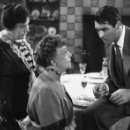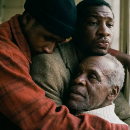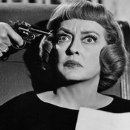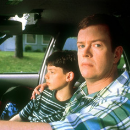CRUCIAL VIEWING
Frank Capra’s ARSENIC AND OLD LACE (American Revival)
Doc Films (University of Chicago) – Friday, 7 and 9:30pm
It’s something of a backhanded compliment when self-serious cinephiles say that a movie is fun, a valuation often used to describe films that cater to popular taste and thus aren’t deemed worthy of thorough examination, or, should they be considered as such, require bending-over-backwards to justify any meaningful assessment. I’m guilty of this myself, and, even after considering my own bias, I’ll admit it’s hard to recall films that I think are both genuinely fun and genuinely good—though one of them is surely Frank Capra’s ARSENIC AND OLD LACE, an adaptation of Joseph Kesselring’s play made almost concurrently with the show’s original Broadway run in 1941 but contractually unable to be released in theaters until after the show ended. Cary Grant stars as Mortimer Brewster, whose Aunts Abby and Martha (Josephine Hull and Jean Adair, reprising their roles from the play) run a quaint boarding house, where they poison lonely older men seeking a room. It’s Halloween, and Mortimer, a cynical theater critic who’s also written several books arguing against wedlock, has just recently married his neighbor, Elaine (Priscilla Lane). While visiting his aunts and brother Teddy (John Alexander, also from the play), Mortimer discovers their secret. Meanwhile, his other brother, Jonathan (Raymond Massey, here resembling Boris Karloff, who was in the play and had wanted the film role; their likeness is a joke throughout), a serial killer, seeks refuge in his aunts’ house along with his plastic surgeon-cum-accomplice, Dr. Einstein (Peter Lorre). The cast (including Edward Everett Horton as the manager of a psychiatric institution) is phenomenal, not least because they were given free reign by Capra to ham it up, the director writing, “I let the scene-stealers run wild. It was a mugger’s ball.” The greatest mugger is Grant, whose frenzied performance astounds, though he’s said to have considered it one of his worst—in my opinion, he’s among several elements that elevate the film to something altogether cinematic. Even the narrow setting (the aunts’ house and the small Brooklyn street on which they live) gets expanded through Capra’s direction, which effectively combines with the performances to merge the nuance of theater with the breadth of cinema. It’s the aesthetic, however, that separates ARSENIC AND OLD LACE from the stage; Capra suggests things having happened, or happening on-screen but obfuscated by something or other, by way of adumbral imagery rather than stagey intimation. Most stupefying are those scenes that take place in the dark, as when Teddy and Dr. Einstein are both tasked, each unaware of the other, with taking bodies down to the cellar for disposal. Dark shadows, the hint of light, and a fleeting image of a dead man’s feet accomplish what can only be done on-screen. During filming, Capra enlisted in the United States Army Signal Corps with a Major’s commission; he was given an extension on reporting to active duty so he could finish editing. When viewed in light of what came next—his lauded WHY WE FIGHT series—as well as before (What is Capra associated with if not a principled, even if skilled, heavy-handedness?), ARSENIC seems to be laughing in the face of danger, proving that fun can be more consequential than it seems. (1944, 118 min, 16mm archival print) KS
ALSO RECOMMENDED
Joe Talbot’s THE LAST BLACK MAN IN SAN FRANCISCO (New American)
Gene Siskel Film Center - Check Venue website for showtimes
San Francisco has served as the backdrop for countless movies over the years; it’s distinct topography and landmarks make it instantly recognizable to an audience. With each film’s reinterpretation, it takes on different roles—as if it were an actor—and differing aspects of the city emerge. In THE LAST BLACK MAN IN SAN FRANCISCO, two lifelong friends navigate gentrification, their friendship, and their families’ pasts in the City by the Bay. Jimmie (Jimmie Fails) and aspiring-playwright Mont (Jonathan Majors) are inseparable pals with a history of squatting, but both are currently crashing at Mont’s grandfather’s house. Jimmie longs for his childhood home, a Victorian house that was built by hand by his grandfather. Jimmie frequently trespasses onto the property, now owned by a white baby-boomer couple, not for nefarious purposes but to provide renovations, much to the owners’ annoyance. After the family suddenly moves out, Jimmie steps in to claim squatter’s rights to reclaim his family’s legacy and to provide a place for Mont to stage a production of his play. THE LAST BLACK MAN IN SAN FRANCISCO explores current issues plaguing the city—gentrification, absurd property costs, and homelessness—with equal parts playfulness and despair. Nostalgic notions of the past are merged with the contemporary realities, yielding a poignant juxtaposition. Do we really not know what we have until we lose it? The film is based on director Joe Talbot and lead actor/writer Jimmie Fails‘ own childhood friendship in the city, which lends an earnestness and truthfulness to the actions depicted on screen. THE LAST BLACK MAN IN SAN FRANCISCO is a unique take on one of California’s most distinct and filmed cities. (2019, 121 mins, DCP Digital) KC
Paul Henreid's DEAD RINGER (American Revival)
Music Box Theatre — Saturday and Sunday, 11am
Bette Davis made DEAD RINGER, a pulpy thriller that's good lurid fun, when she was in her mid-fifties, well into the period of her career when filmmakers exploited a certain delightfully coldblooded aspect of her persona—what David Thomson called "a woman living ruthlessly by her wits"—for its horror/camp appeal. This movie clearly hoped to tap into the public's appetite for Davis in high-camp mode: "For 'Baby Jane' people!," proclaimed the poster. What we have here is a boxing match between estranged identical twin sisters Edith and Maggie, both played by Davis in a meaty double role. Maggie is a wealthy high-society woman, with a mansion and all the accoutrements of same: butler, chauffeur, and maid. Edith is a broke, thwarted saloonkeeper in a seedy part of town. Both are nasty pieces of work. The death of Maggie's husband brings the two together again, but the story twists and turns around secrets that it's best you discover for yourself. (I couldn't help feeling, though, that had Forensic Files been around back then, they'd have sorted these two out rather quickly). A dissolute Peter Lawford is also on hand, as is Karl Malden as a straight-shooting police sergeant. Paul Henreid directed the movie (yes, that Paul Henreid—Victor Laszlo from CASABLANCA, who'd also starred opposite Davis in NOW, VOYAGER). He shows a shadowy flair for the LA locations and a sure sense of suspense. The scenes in Edith's cocktail lounge have a snazzy jazz noir feel, thanks to the top real-life organ/drums combo of Perry Blackwell and Kenny Dennis. By '64, cinematographer Ernest Heller had practice with this sort of thing: he'd already photographed Davis as twins for 1946's A STOLEN LIFE. His trick photography here, when combined with deft direction and cutting, is fairly seamless. The picture's sole ambition is to shock; Andre Previn's music, with its sudden blasts and spooky harpsichord, does its best to oblige. We are more or less unshockable today, but the movie can still startle. I gasped a few times, and I admired how Henreid seemed to sincerely believe in his crass story. As for Davis, her power comes precisely from her lack of knowing distance from the material. Instead, she turns upon it all of her abrasive glory, those amazing eyes of hers flashing with bottomless malice. (1964, 116 min, 35mm) SP
Jacqueline Audry’s OLIVIA (French Revival)
Gene Siskel Film Center — Friday, 4pm, Saturday, 3:15pm, and Monday and Wednesday, 6pm
An alternate title for Jacqueline Audry’s OLIVIA is THE PIT OF LONELINESS, but the girls boarding school that is the setting for this tale of lesbian desire is the farthest thing from lonely. Lustful, jealous, heartbroken, adoring, yes, but never lonely. Olivia (Marie-Claire Olivia), the English girl who transfers from a strict British boarding school to the much more relaxed French school run by Mlle. Julie (Edwige Feuillère) and Mlle. Cara (Simone Simon) is the protagonist whose experiences form the window onto the circle of intrigue every girl faces when she enters the school. Feuillère is magnificent as the charismatic Julie, a skilled sexual predator who, judging by the swooning behavior of both current and former students, appears to seduce every girl in her care. Her competition with Cara, who is her embittered and sickly former lover, is a kind of spectator sport as the girls speculate about whether Olivia will become a “Julie-ist” or a “Cara-ist.” All it takes is for Julie to recite Racine in one of her famous evening readings to hook Olivia, but we see from her attentions to a truly beautiful girl and her criticisms of Olivia’s looks and scholastic abilities that Julie simply wants to win the game. Jacqueline Audry filled a unique place in French film history between the Nazi-dictated films of the Occupation and those of the Nouvelle Vague, offering literary adaptations in the quality tradition to audiences hungry for entertainment, but with a decidedly feminine twist. Her direction of the script penned by her sister, Colette Audry, from the semiautobiographical novel by English writer Dorothy Strachey Bussy, illustrates the fine art of seduction. Audry fairly turns the entry hall of the school into a character, with its winding staircase buzzing with human activity suggestive of the snake in the Garden of Eden. Her pièce de résistance, a costume ball, forms the perfect crescendo to her slowly built symphony of emotions. Her treatment of the very few men that appear in the film is best observed when Julie runs into a former student at a restaurant in Paris. Audry’s camera angle reduces the student’s fiancé in the background to an inconsequential speck. Simon is a lovely, but shrill, Cara, and great comic performances by Yvonne de Bray as Victoire, the school cook, Suzanne Dehelly as Mlle. Dubois, the math teacher, and Lesly Meynard as dour German teacher Frau Riesener round out a uniformly fine production. (1951, 96 min, DCP Digital) MF
Cheryl Dunye’s THE WATERMELON WOMAN (American Revival)
Comfort Film at Comfort Station Logan Square (2579 N. Milwaukee Ave.) – Wednesday, 8:30pm (Free Admission; Outdoor Screening)
It’s 1997 in Philadelphia, but Cheryl (Cheryl Dunye) can’t get her mind off the 1930s. An aspiring filmmaker who pays the bills by juggling various wedding gigs and shifts at a video store, Cheryl becomes fascinated by an obscure film actress named Fae Richards—also known as The Watermelon Woman—who played Black “mammy” roles throughout the ‘30s. Cheryl turns this obsession into her first real film project, a documentary that leads to a journey of finding forgotten pieces of Black lesbian history and filmmaking. At the same time, Cheryl navigates her budding relationship with a white woman, Diana (Guinevere Turner), often mirroring Richards’ rumored relationship with director Martha Page. Dunye makes it clear that THE WATERMELON WOMAN is both a Black film and a lesbian film, and that acknowledging the importance of how those identities relate to one another is integral to understanding a broader picture of queer history in America. This is not a film that cares about a white gaze—nor should it—but it is crucial viewing all the same. The dialogue is sometimes charming, sometimes awkward, and always laugh-out-loud funny, making THE WATERMELON WOMAN a breeze to watch. But there is real heart and substance in addition to all that; the yearning for a past that was never yours, a future that isn’t quite here yet, and an identity that guides how you move through the world. (1997, 90 min, Digital Projection) CC
Nanfu Wang and Jialing Zhang’s ONE CHILD NATION (New Documentary)
Landmark’s Century Center Cinema – Check Venue website for showtimes
During the 1970s, China’s population reached one billion. Fearing widespread famine, the government imposed a limit of one child per family and began enforcing it in 1979 with propaganda and strong-arm tactics. As the only children raised in the first years of this policy have reached adulthood, some of them are exploring its effects, intended and otherwise, in feature films, live-action and animated shorts, and documentaries. With ONE CHILD NATION, the Grand Jury Prize winner at the 2019 Sundance Film Festival, Nanfu Wang and Jialing Zhang have created a wide-ranging documentary that begins with Wang’s family, who resisted forced sterilization of her mother and eventually got the family planning bureau to allow her have another child after a wait of five years, a concession they eventually granted to many rural families with farms to run. Not many families were so lucky. Resisters had their homes bulldozed and late-term pregnancies aborted against their will. Many baby girls—Chinese families still want sons—were abandoned by roadsides or in marketplaces, where they died or were scooped up and sold to orphanages for adoption outside the country. And in a sobering reminder of what has happened at the southern border of the United States, children were taken from their families and adopted out in a moneymaking scheme for the Chinese orphanages. The pain of this 35-year period is still felt by the people Wang interviews, but their responses that they could do nothing sound hollow to Wang, who lives in the U.S. and who feels there is no real difference between forced abortion and restrictions on abortion—both trample on women’s choice. Witnessing the current, determined resistance to the proposed forced extradition of Hong Kong residents to mainland China highlights the profound psychosocial differences between populations who have been subjected to prolonged oppression and those who have grown up with the right to free expression. Human population growth is a real problem, but ONE CHILD NATION argues through the stark emotions of the midwife, artist, family planning officials, and affected families who spoke out for the camera that legislating it out of existence is not the answer. (2019, 89 min, DCP Digital) MF
Ingmar Bergman's SUMMER WITH MONIKA (Swedish Revival)
Doc Films (University of Chicago) - Saturday, 7 and 9:30pm
That the story of a willful teenager and her summer romance was picked up by Kroger Babb (the man behind such titles as SHE SHOULDA SAID NO) and distributed in the U.S. as an exploitation film should come as no surprise. The film was recut, with emphasis on Harriet Andersson's scandalous nudity, and retitled MONIKA: THE STORY OF A BAD GIRL. "Naughty and Nineteen" promotional posters declared. Monika is a rebellious, sexually experienced teenager who winds up pregnant. We even see her ass. It's not a tough sell. But this is Bergman. Andersson's Monika isn't offered up to the audience as an object for its salivation and sanctimony. She is never really punished for her "sins"--not cowed into domesticity or subjected to whatever horrors typically await "bad girls." She is triumphant to the end. It is she who chooses Harry Lund, as if at random, to provide her with a light and a date to the cinema that first night. "I'm crazy about you," she says, addressing Harry but gazing at her own reflection. She is a fervent consumer of love on screen and in print, and she has decided to embark on a summer romance of her own. Harry Lund, a shop clerk from a petit bourgeois home, is not exactly the stuff of dreams. Next to Monika, he is about as charismatic as a pat of butter. But he has a nice face and a kind demeanor, and, most importantly, he's game. Monika has enough life for the both of them. She commands the screen. Yes, we see her ass, but she also holds our gaze in a radically drawn out extreme close-up. At about 30 seconds, it's long enough that we can't help but feel her mind churning, blood pumping, and life bursting just below the surface. What are we to think of Monika? Is she really so bad? So she chooses to spend a summer on a boat cruising along the Swedish coast, bathing naked in tide pools and dancing on piers. Given the opportunity, what sort of soulless monster would do otherwise? And what's her alternative? To work in some cold cellar, selling dry goods to leering customers. What we see of her life in working class Stockholm puts into sharp relief the couple's idyllic summer days (captured in all their sun-dappled glory by Gunnar Fischer). Her romanticism won't allow her to accept the everyday drudgery that's her lot. She is, at times, vulgar and petulant, self-absorbed and needlessly cruel--a typical teenager. But even at her worst, she's captivating. Monika is as much Andersson's creation as she is Bergman's. For the director no other actress could have played the part. No other girl "could be more Monika-sh." Andersson imbues the role with an energy that is both preternatural and wholly organic. When Harry jumps and shouts and acts wild, it's a performance. He is playacting rebellion. Monika seems at home in that wildness. Freedom suits her. However we might judge her final act, it's impossible to spend an hour and a half watching her live, so naturally and irresistibly, and wish to see that freedom tempered. (1953, 97 min, 35mm) EJC
Harold P. Warren's MANOS: THE HANDS OF FATE (American/Cult Revival)
Beverly Arts Center - Wednesday, 7:30pm
The sadness that washed over me the first time, many years ago, that I ever saw an episode of Mystery Science Theater 3000 remains a bitter ache that, like a cut inside your mouth, seems to reopen and refresh itself every time you notice it. Lovely, idiosyncratic, intensely felt, and deeply strange films were unearthed on that show, movies that in their inimitable misunderstandings of classic Hollywood idioms and troubled relationships with narrative were like mysterious blind alleys branching off the tedious main thoroughfares of cinema. Delirious, visionary, and transformative, movies like BRIDE OF THE MONSTER, THE INDUSTRUCTIBLE MAN, THE AMAZING TRANSPARENT MAN, and NIGHT OF THE BLOOD BEAST, movies that I treasure, movies that are among the greatest of their times, were made into mere setups for cruel mockery on the part of comedians whose interest in cinema was apparently limited to finding hilariously wanting anything that didn't look like the anonymous productions of well-paid professionals. In January, 1993, Mystery Science Theater 3000 aired one of its most notorious episodes when the cast set up to piss all over a largely-forgotten horror film from 1966, made by a cast and crew who were almost all complete amateurs and produced by an insurance salesman merely so as to win a bet. It was MANOS: THE HANDS OF FATE, directed, produced, written by, and starring Harold P. Warren. Much has been written on MANOS, nearly all of it supporting the proposition that it is not merely bad but amazingly bad, a film admirable and remarkable precisely because it is a contender for the worst film ever made. It is not the worst film ever made. In fact, it is extraordinary, a mesmerizing and precious piece of film history. The bare plot line is easily summarized, though to do so, as with all great cinema, is to miss everything of note in the film. A married couple and their young daughter lose their way and end up at a decrepit old house manned by a disturbed cripple named Torgo. The house is the home of the Master, a priest of some sort, endowed by the god Manos with undisclosed powers that may include mental domination. The Master rules over a cult of scantily-clad and in-fighting women, his brides, and contends with Torgo for sexual access to them. The family finds themselves turned into unwilling battlegrounds for this contest between Torgo and the Master. What matters, though, is not the silly erotic mysticism of the story but the movie's rhythms, its style, its camerawork, which in their outsider brutishness combine to form nothing less than a window into an alternative conception of cinema itself. Where many movies strive for a rough continuity between our experience of the world and the constructed phenomenology of the art world, MANOS jettisons any coherence of character or theme, all but the slightest glimmer of narrative structure, and the rudimentary foundations of cinematic convention. One's experience of time and space, critical philosophy recognizes, is not found within that which we perceive but in fact structures the very act of perception. Ingrained within the very fabric of reason, the intuitions of space and time allow for, shape, and control the kinds of sensations we're capable of having. To watch MANOS: THE HANDS OF FATE is to encounter a direct assault upon those representations. It's a project doomed to fail, a doom echoed by the overarching doom that the ever-approaching, never appearing god Manos himself represents in the film. But it's a film that in its failure is nothing less than astonishing. Note: The version of MANOS: THE HANDS OF FATE being shown has been lovingly restored by Benjamin Solovey from the original 16mm workprint. It has never looked better, even at the 1966 premiere. If you are only familiar with the film from the washed-out, cropped version circulating in the public domain, you are in for a revelation. (1966, 69 min, Digital Projection) KB
Agnès Varda's THE GLEANERS AND I (Documentary Revival)
PO Box Collective (6900 N. Glenwood Ave.) - Friday, 8pm (Free Admission)
Agnès Varda, arguably the first filmmaker of the French New Wave, builds an easy rambling and revelatory road movie in THE GLEANERS AND I, an essay film about the historical French custom of gleaning, the act of collecting crops left to waste after the harvest. Varda takes to the motorways with her digital camera and captures gleaning as it is in contemporary French life. She interviews potato farmers, crust punks, gypsies, grocers, justices, vintners, and artists, illuminating lots of sympathetic thematic tensions along the way. Varda doesn't linger in interviews; she brings us only snippets of the people she speaks with, capturing their charm in a few juicy clips. Varda uses GLEANERS to consider her own aging, revolving technology, the ethics of waste, and, probably most poignantly, the sliding economic realities that brought gleaning back as a common practice. (2000, 79 min, Video Projection) CL
Quentin Tarantino’s ONCE UPON A TIME… IN HOLLYWOOD (New American)
Music Box Theatre (70mm through Tuesday; DCP Wednesday and Thursday) and Logan Theatre (35mm and Digital); plus additional area theaters (all digital presentations) – Check Venue websites for showtimes
Having finally arrived, Quentin Tarantino’s ONCE UPON A TIME… IN HOLLYWOOD could not be any truer to its creator’s decades-long fascination and obsession with 1960’s and 70’s cinema, though it also feels slightly atypical for the director. Without giving anything away, the long blocks of back-and-forth dialogue that Tarantino usually indulges in have begun to give way to more preoccupation with staging, fourth-wall-breaking camera moves, and all around color, resulting in an ambling and evocative dreamscape rife with a whole host of characters. Atmosphere has never been so palpable and dialogue between characters so natural in a Tarantino film—there’s nary a monologue in sight. The film begins at the tail end of an era in Hollywood filmmaking in which rapidly-fading TV actor/cowboy “heavy" Rick Dalton (Leonardo DiCaprio) is seeing his career head towards Italy, specifically towards the cheap and fast genre films of Sergio Corbucci. Burt Reynolds went to Rome to work with Corbucci, Eastwood did the same for Sergio Leone, along with character actors like Lee Van Cleef, and so did one-time TV western stars like Ty Hardin (Rick Dalton is probably most similar to the latter). In the cases of Reynolds and Eastwood, their careers were revitalized by the Italian industry, but many others, like Hardin, were pushed further into obscurity. While watching his star power sputter out in what he perceives to be his twilight years, Dalton is accompanied by his sidekick/assistant/stunt man/reflective image Cliff Booth (Brad Pitt), who lives in a trailer behind a drive-in theater, while Dalton lives in a Benedict Canyon home (with pool, naturally). He lives next door to Roman Polanski and Sharon Tate (Margot Robbie), and Manson family members are prowling around the streets of L.A., hollering at police officers and offering up blowjobs while they try to hitch back to their nesting grounds at the Spahn Ranch. Tarantino covers a lot of ground in ONCE UPON A TIME—an entire landscape of stories is on view, not dissimilar to something like Robert Altman’s NASHVILLE or even Richard Linklater’s DAZED AND CONFUSED. The film has a near three-hour running time, but three hours that have never seemed so short and compact in recent film memory. The movie has a blink-or-you’ll-miss-it pace, rare for a director who sometimes has a tendency to halt the rush of his work with overly bravura dialogue sequences. Tarantino seems to find fresh new ground within his already steadfast movie-making abilities, to let the scope of his powers extend further than previously thought possible. He barely pauses for the chance to show off his noted screenwriting abilities, and instead chooses to craft an ensemble work that somehow feels more epic than any of his films have ever felt; this is Los Angeles completely transformed back to the summer of 1969, in a way that only a very large budget and large talent could realize. It might possibly be one of the last times we see Hollywood bankroll such an ambitious project, by an auteur still powerful enough to retain final cut. ONCE UPON A TIME isn’t as cynical a look at Hollywood as other films have been (such as Altman’s THE PLAYER—even though it does share a curious opening shot). It’s more bittersweet nostalgia, and is perhaps Tarantino’s breeziest and best work to date; his entire career as a director bursts forth as both a marvelously crafted time-capsule and a fantasy-land-rendering of a mythical Hollywood, specifically the place where dreams, however real, are made. (2019, 165 min, 70mm/35mm/DCP Digital) JD
MORE SCREENINGS AND EVENTS
The Silent Film Society of Chicago presents the Silent Summer Film Festival this weekend. Screening are Chester M. Franklin’s 1922 film THE TOLL OF THE SEA on Friday at 8pm; a “Wild West” Matinee,” with the Buster Keaton shorts OUT WEST (1918) and THE PALEFACE (1920), and the Harold Lloyd short TWO-GUN GUSSIE (1918) on Saturday at 1pm; Yakov Protazanov’s 1924 Soviet film AELITA: QUEEN OF MARS on Saturday at 8pm; and Alan Hale, Sr.’s 1927 film RUBBER TIRES on Sunday at 3pm. Screenings are at the Filament Theatre (4041 N. Milwaukee Ave.) and all feature live accompaniment by Jay Warren. More info at http://silentfilmchicago.com.
Instituto Cervantes (31 W. Ohio St.) screens Jon Garaño and Aitor Arregi's 2017 Spanish film GIANT (114 min, DVD Projection) on Tuesday at 7pm. Free admission.
Also at the Gene Siskel Film Center this week: Maia Wechsler’s 2018 documentary IF THE DANCER DANCES (87 min, DCP Digital) plays for a week; and the Black Harvest Film Festival continues with narrative features: Edward J. Wilson’s LOST GURL and Robert Rippberger’s STRIVE; documentary features: Emily Harrold’s WHILE I BREATHE, I HOPE and Jeffrey Wolf’s BILL TRAYLOR: CHASING GHOSTS; and shorts programs: “Love African-American Style,” “Color Me Creative,” and “Black History—Lost and Found.” Visit the Siskel website for details.
Also at Doc Films (University of Chicago) this week: Boris Ingster’s 1940 film STRANGER ON THE THIRD FLOOR (64 min, 35mm archival print) is on Wednesday at 7pm; and John Sayles’ 1991 film CITY OF HOPE (129 min, 35mm) is on Thursday at 7pm.
Also at the Music Box Theatre this week: Jennifer Kent’s 2019 film THE NIGHTINGALE (136 min, DCP Digital) opens; Ljubomir Stefanov and Tamara Kotevska’s 2019 Macedonian documentary HONEYLAND (85 min, DCP Digital) is on Saturday and Sunday at 11:15am; Richard Wallace’s 1929 film INNOCENTS OF PARIS (78 min, 35mm) is on Thursday at 7pm, showing with a roughly 40-minute selection of short films from 1929 (16mm); and Andrew Fleming’s 1999 film DICK (94 min, DCP Digital) is on Friday and Saturday at Midnight.
Facets Cinémathèque plays Benjamin Gilmour’s 2018 Australian film JIRGA (78 min, Video Projection) and Robi Michael’s 2019 film EVERY TIME I DIE (98 min, Video Projection) for week-long runs.
ACRE (1345 W. 19th St.) presents a double feature screening of David France’s 2012 documentary HOW TO SURVIVE A PLAGUE (110 min, Video Projection) and Robin Campillo’s 2017 French film BPM (BEATS PER MINUTE) (143 min, Video Projection) on Sunday at 5pm. Followed by a discussion. Free admission.
The ReelAbilities Film Festival screens Catherine Tambini's 2019 documentary PERFECTLY NORMAL FOR ME (60 min, Video Projection) on Thursday at 6:30pm at the Chicago Cultural Center. Showing with Ryan Mayers’ 2019 documentary short JMAXX AND THE UNIVERSAL LANGUAGE (13 min). Free admission.
The Chicago Cultural Center screens Laurie Coyle’s 2018 documentary ADIOS AMOR: THE SEARCH FOR MARIA MORENO (58 min, Video Projection) on Saturday at 2pm. Followed by a discussion; and hosts the Cinema/Chicago screening of Paolo Zucca's 2018 Italian film THE MAN WHO BOUGHT THE MOON (102 min, Video Projection) is on Wednesday at 6:30pm. Free admission.
The Millennium Park Summer Film Series (at the Jay Pritzker Pavilion) presents an outdoor screening of Joel Zwick's 2002 film MY BIG FAT GREEK WEDDING (95 min) on Tuesday at 6:30pm. Free admission.
CINE-LIST: August 16 - August 22, 2019
MANAGING EDITOR // Patrick Friel
ASSOCIATE EDITORS // Ben Sachs, Kathleen Sachs, Kyle A. Westphal
CONTRIBUTORS // Kian Bergstrom, Elspeth J. Carroll, Cody Corrall, Kyle Cubr, John Dickson, Marilyn Ferdinand, Christy LeMaster, Scott Pfeiffer









